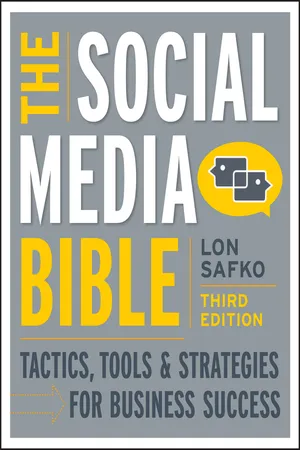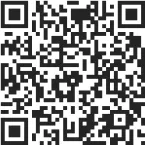![]()
PART 1
TACTICS AND TOOLS
Part I of this book is all about the tactics and tools of social media. I discuss in these chapters what all of the many components of social media are: What a blog is, a podcast, virtual worlds, lifecasting, mobile marketing, photo sharing, and more.
It is important to understand the terminology, the technology, the application, and the companies providing those services. While this section is not a how-to, it does explain a great deal of the details and techniques to becoming proficient at each application.
Let’s start with the basics: “What Is Social Media?”
![]()
CHAPTER 1
What Is Social Media?
Social media is the media we use to be social. That’s it.
That really is the short answer. The story is in the tactics of each of the hundreds of technologies, all of the tools that are available for you to connect with your customers and prospects, and the strategies necessary to use these tactics and tools effectively.
Ask Your Audience
When I began writing this book, I wanted to hear what my audience wanted in a book. I have written six previous books and I knew there was a standard formula for writing a typical business book: 250 pages, 23 chapters, 3,000 words per chapter. But I wasn’t sure if this book should follow that formula. Did the audience for a bible on social media want a typical business book? I didn’t know, so, I asked them.
I knew that if I asked my audience and delivered what they wanted, it would be a success. Go figure, ask your customers what they want in a product. Then, you told me some interesting facts. First, you didn’t want another typical business book on social media. You asked for three books in one: Tactics, in which everything is explained; Tools, with which you can find a comprehensive list of all the companies providing social media services; and Strategy, with which you can apply all that you have learned from Part I and Part II.
This approach of listening to my customers obviously worked. The Social Media Bible, first edition, sold out in the first four days across the country, has been among the top 10 best-selling books in America, and has hit the number one best-selling book spot in both “Business” and “Marketing” categories on Amazon.
The second fact I learned was from the first two questions on the survey, “Can you define social media?” and “Do you believe that social media would have a significant impact on you and your business?”
What I learned by asking my audience these two questions was that 66.4 percent said that they couldn’t define social media and the remaining third lied. If it takes me nearly 26 chapters and more than 600 pages to define social media, they didn’t know, not even the social media experts and gurus.
The second really interesting fact I learned was that 99.1 percent, nearly everyone, said they knew social media was going to have a significant impact on them personally and their businesses.
These two statistics told me and the publisher that two-thirds of everyone interviewed didn’t know what social media was, but that it was coming for them.
So What Is It?
The first part of the terminology, social, refers to the instinctual needs we humans have to connect with other humans. We have been doing that in one form or another since our species began. We have a need to be around and included in groups of similar like-minded people with whom we can feel at home and comfortable sharing our thoughts, ideas, and experiences.
The second part of that term refers to the media we use with which we make those connections with other humans. Whether they are drums, bells, the written word, the telegraph, the telephone, radio, television, e-mail, websites, photographs, audio, video, mobile phones, or text messaging, media are the technologies we use to make those connections.
The application of the term social media in this book is about how we can use all of these technologies effectively to reach out and connect with other humans, create a relationship, build trust, and be there when the people in those relationships are ready to purchase our product offering.
What social media is not is a box of silver bullets given to us by aliens that will instantly solve all of our marketing woes and create instant wealth for all involved. Too many people are viewing social media as a foreign and strange set of technologies that they may or may not want to use to market themselves, their companies, their products, and their services.
In my keynotes, two questions always asked are, “Should I be doing social media marketing?” My answer is “Remove the term social media and ask it again. Should I be doing marketing?” See how ridiculous that sounds. The second question is, “How much should I spend on social media marketing?” I reply with “Remove the term social media again. How much should I spend on marketing?” And, of course, the answer to both is “Yes, and as much as you can!”
Social media is only a new set of tools, new technology that allows us to more efficiently connect and build relationships with our customers and prospects. It’s doing what the telephone, direct mail, print advertising, radio, television, and billboards did for us up until now. But social media is exponentially more effective.
Why Social Media?
The reason social media is so much more effective than the conventional marketing that we’ve done for the last 6,000 years is that it’s two-way communication, not pontification. Since we’ve been selling goats in the desert, we would stand on a rock and shout out the features and benefits of owning a goat. And, if we chose our words correctly and hit enough of the audience’s psychological hot buttons, our prospect would become a customer. Nothing has changed in 6,000 years. Until now.
There is what I call “A Fundamental Shift in Power.” It’s a shift from pontification to two-way communication and it’s a shift about which we no longer control our corporate message. No longer does the consumer trust corporate messages. They don’t trust and don’t want to hear our commercials any longer. They want their information from people they know, have a relationship with, and share a bond with through trust. They want to be educated by, hear their news from, and get their product reviews by people they know and trust. They want to share their experiences, both good and bad, with people who trust them.
With this Fundamental Shift comes a new way to communicate. The new way to sell is not to sell at all. In fact, if you use social media to sell, you will get flamed. Social media marketing is all about listening first, understanding the conversation, and speaking last.
Social media marketing is like going to a networking event, a party, a trade show, sporting event, church, or anywhere that large groups of people gather. When you enter, you will see small groups of three to five people huddled together. Let’s now suppose we use our conventional marketing approach.
You walk up to the group, interrupt everyone, announce your name, and start telling everyone what you do for a living, what you sell, and that they should buy from you! It’s the radio car commercials that yell at you from their echo chamber “Sunday! Sunday! Sunday!” You’ve heard them. What will happen?
You probably will make everyone angry at you, everyone would walk away, and you might get slapped in the lips. Because that type of behavior in a social situation is completely inappropriate. Let’s rewind and try the new marketing approach.
You enter the room, choose a group, walk up to that group and say nothing. You listen first. You understand what is already being said and when you have something of value to contribute to that conversation, you wait for a break, and politely share your ideas. The reaction to this approach is significantly better. At that moment you now become part of that group, that network, and you instantly have credibility and trust.
Then as the conversation continues, someone will eventually ask you, “So, w...

